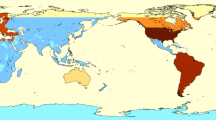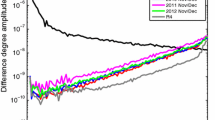Abstract
Three GOCE-based gravity field solutions have been computed by ESA’s high-level processing facility and were released to the user community. All models are accompanied by variance-covariance information resulting either from the least squares procedure or a Monte-Carlo approach. In order to obtain independent external quality parameters and to assess the current performance of these models, a set of independent tests based on satellite orbit determination and geoid comparisons is applied. Both test methods can be regarded as complementary because they either investigate the performance in the long wavelength spectral domain (orbit determination) or in the spatial domain (geoid comparisons). The test procedure was applied to the three GOCE gravity field solutions and to a number of selected pre-launch models for comparison. Orbit determination results suggest, that a pure GOCE gravity field model does not outperform the multi-year GRACE gravity field solutions. This was expected as GOCE is designed to improve the determination of the medium to high frequencies of the Earth gravity field (in the range of degree and order 50 to 200). Nevertheless, in case of an optimal combination of GOCE and GRACE data, orbit determination results should not deteriorate. So this validation procedure can also be used for testing the optimality of the approach adopted for producing combined GOCE and GRACE models. Results from geoid comparisons indicate that with the 2 months of GOCE data a significant improvement in the determination of the spherical harmonic spectrum of the global gravity field between degree 50 and 200 can be reached. Even though the ultimate mission goal has not yet been reached, especially due to the limited time span of used GOCE data (only 2 months), it was found that existing satellite-only gravity field models, which are based on 7 years of GRACE data, can already be enhanced in terms of spatial resolution. It is expected that with the accumulation of more GOCE data the gravity field model resolution and quality can be further enhanced, and the GOCE mission goal of 1–2 cm geoid accuracy with 100 km spatial resolution can be achieved.
Similar content being viewed by others
References
Altamimi Z, Colillieux X, Legrand J et al (2007) ITRF2005: a new release of the International Terrestrial Reference Frame based on time series of station positions and Earth orientation parameters. J Geophys Res 112(B9): B09401
Bock H, Jaggi A, Meyer U, Visser P, van den IJssel J, Van Helleputte T, Heinze M, Hugentobler U (2011) GPS derived orbits for the GOCE satellite. J Geod (this issue)
Bruinsma SL, Marty JC, Balmino G, Biancale R, Foerste C, Abrikosov O, Neumayer H (2010) GOCE gravity field recovery by means of the direct numerical method. In: Proceedings of the ESA living planet symposium, 28 June–2 July 2010, Bergen, Norway. See also: http://earth.esa.int/GOCE
ESA (2010) http://www.esa.int/SPECIALS/GOCE/SEMY0FOZVAG_0.html
Förste Ch, Flechtner F, Schmidt R, Stubenvoll R, Rothacher M, Kusche J, Neumayer H, Biancale R, Lemoine J-M, Barthelmes F, Bruinsma S, Koenig R, Meyer Ul (2008) EIGEN-GL05C: a new global combined high-resolution GRACE-based gravity field model of the GFZ-GRGS cooperation. Geophysical Research Abstracts, vol 10. EGU2008-A-03426, 2008 SRef-ID: 1607-7962/gra/EGU2008-A-03426, 2008
Gruber Th (2004) Validation concepts for gravity field models from satellite missions. In: Lacoste H (ed) Proceedings of the 2nd international GOCE user workshop “GOCE, The Geoid and Oceanography”, ESA SP-569, ESA. ISBN (Print):92-9092-880-8, ISSN:1609-042X
Gruber Th (2009) Evaluation of the EGM2008 gravity field by means of GPS-levelling and sea surface topography solutions. Newton’s Bull Bur Gravimétrique Int (BGI)/Int Geoid Service (IGeS) 4: 3–17
Gruber Th, Rummel R, Abrikosov O, van Hees R (2010) GOCE level 2 product data handbook, issue 4.2. ESA
Heiskanen WA, Moritz H (1967) Physical geodesy. W.H. Freeman & Co Ltd, New York
Hirt C, Featherstone W, Marti U (2010) Combining EGM2008 and SRTM/DTM2006.0 residual terrain model data to improve quasigeoid computations in mountainous areas devoid of gravity data. J Geod 84(9): 557–567. doi:10.1007/s00190-010-0395-1
Hirth C (2011) Assessment of EGM2008 over Germany using accurate quasigeoid heights from vertical deflections, GCG05 and GPS levelling. Zeitschrift für Geodäsie, Geoinformation und Landmanagement (zfv) (accepted)
Hofmann-Wellenhof B, Moritz H (2006) Physical geodesy, 2nd edn. Springer, Wien
Huang J, Kotsakis C (eds) (2008) External quality evaluation reports of EGM08. Newton Bulletin no. 4. International Association of Geodesy and International Geoid Service. ISSN:1810-8555
IERS International Earth Rotation Service (2008) http://www.iers.org
Ihde J, Sacher M (2002) EUREF publication 11/I, vol 25. Mittelungen des Bundesamtes für Kartographie und Geodäsie, Frankfurt/Main
Kenyeres A, Sacher M, Ihde J, Denker H, Marti U (2007) EUVN_DA: establishment of a European continental GPS/levelling network. In: Proceedings of the 1st international symposium of the international gravity field service, Istanbul 2006. Harita Dergisi, special issue, no. 18. ISSN:1300-5790
Knudsen P, Bingham R, Andersen O (2011) Enhanced mean dynamic topography and ocean circulation estimation using GOCE preliminary models. J Geod (this issue)
Mayer-Gürr T, Kurtenbach E, Eicker A (2010) http://www.igg.uni-bonn.de/apmg/index.php?id=itg-grace2010
Migliaccio F, Reguzzoni M, Sanso F, Tscherning CC, Veicherts M (2010) GOCE data analysis: the space-wise approach and the first space-wise gravity field model. In: Proceedings of the ESA living planet symposium, 28 June–2 July 2010, Bergen, Norway. ESA SP-686. See also: http://earth.esa.int/GOCE
NGS (1999) http://www.ngs.noaa.gov/GEOID/GPSonBM99/gpsbm99.html
Noomen R, Ambrosius BAC, Leenman H, Wakker KF (1998) Precise orbit computations of LAGEOS. In: AIAA-88-4213-CP, AIAA/AAS astrodynamics conference, Minneapolis, Minnesota, August 15–17, 1998
Pail R, Goiginger H, Mayrhofer R, Schuh WD, Brockmann JM, Krasbutter I, Höck E, Fecher T (2010) GOCE gravity field model derived from orbit and gradiometry data applying the time-wise method. In: Proceedings of the ESA living planet symposium, 28 June–2 July 2010, Bergen, Norway. ESA SP-686. See also: http://earth.esa.int/GOCE
Pail R, Bruinsma S, Migliaccio F, Förste Ch, Goiginger H, Schuh W-D, Höck E, Reguzzoni M, Brockmann JM, Abrikosov O, Veicherts M, Fecher T, Mayrhofer R, Krasbutter I, Sansò F, Tscherning CC (2011) First GOCE gravity field models derived by three different approaches. J Geod (this issue)
Pavlis DE, Poulouse S, McCarthy JJ (2006) GEODYN operations manual. Contractor report. SGT Inc., Greenbelt
Pavlis NK, Holmes SA, Kenyon SC, Factor JK (2008) An Earth gravitational model to degree 2160: EGM2008. Presented at the 2008 general assembly of the European Geosciences Union, Vienna, Austria, April 13–18, 2008
Rapp RH (1997) Use of potential coefficient models for geoid undulation determinations using a spherical harmonic representation of the height anomaly/geoid undulation difference. J Geod 71: 282–289
Rummel R, Gruber T, Koop R (2004) High level processing facility for GOCE: products and processing strategy. In: Lacoste H (ed) Proceedings of the 2nd international GOCE user workshop “GOCE, the geoid and oceanography”, ESA SP-569
Scharroo R, Visser PNAM (1998) Precise orbit determination and gravity field improvement for the ERS satellites. J Geophys Res 103(C4): 8113–8127
van den IJssel J, Visser PNAM (2003) Champ precise orbit determination using GPS data. Adv Space Res 31(8): 1889–1895
Van Helleputte T, Visser P (2007) GPS based reduced dynamic orbit determination using accelerometer data. In: Stengle T (ed) 20th International symposium on space flight dynamics, September 24–28, 2007. NASA/CP-2007-214158, Annapolis, MD, USA, pp 1–7
Visser PNAM (2005) ERS-2 orbit computations with CHAMP- and GRACE-based gravity field models. Adv Space Res 36(3): 454–459
Visser PNAM, Scharroo R, Ambrosius BAC (2002) Application of ERS-2 PRARE data for orbit determination and gravity field and station coordinate estimation. Adv Space Res 30(2): 249–254
Visser PNAM, van den IJssel J, Van Helleputte T, Bock H, Jaeggi A, Beutler G, Hugentobler U, Svehla D, Heinze M (2009) Orbit determination for the GOCE satellite. Adv Space Res 43(5): 760–768. doi:10.1016/j.asr.2008.09.016
Author information
Authors and Affiliations
Corresponding author
Rights and permissions
About this article
Cite this article
Gruber, T., Visser, P.N.A.M., Ackermann, C. et al. Validation of GOCE gravity field models by means of orbit residuals and geoid comparisons. J Geod 85, 845–860 (2011). https://doi.org/10.1007/s00190-011-0486-7
Received:
Accepted:
Published:
Issue Date:
DOI: https://doi.org/10.1007/s00190-011-0486-7




